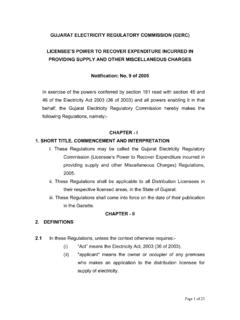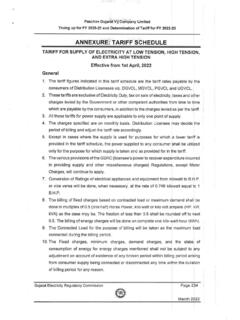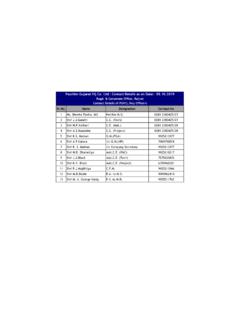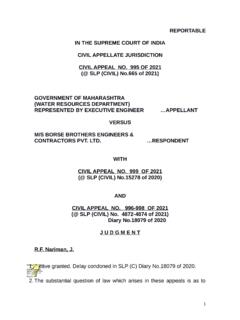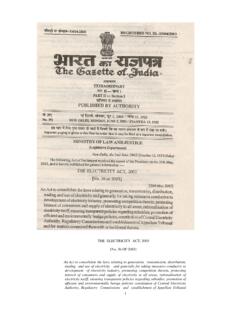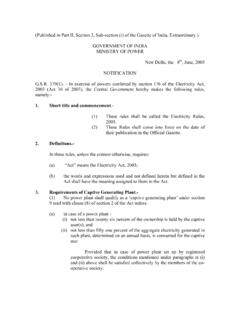Transcription of THE ELECTRICITY ACT, 2003
1 THE ELECTRICITY ACT, 2003 . INTRODUCTORY. PART I. PRELIMINARY. 1. Short title, extent and commencement 2. Definitions PART II. NATIONAL ELECTRICITY POLICY AND PLAN. 3. National ELECTRICITY Policy and Plan 4. National policy on stand alone systems for rural areas and non- conventional energy systems 5. National policy on electrification and local distribution in rural areas 6. Obligations to supply ELECTRICITY to rural areas PART III. GENERATION OF ELECTRICITY . 7. Generating company and requirement for setting up of generating station 8. Hydro-electric generation 9. Captive generation 10. Duties of generating companies 11. Directions to generating companies PART IV. LICENSING. 12. Authorised persons to transmit, supply, etc., ELECTRICITY 13. Power to exempt 14. Grant of licence 15. Procedure for grant of licence 16.
2 Conditions of licence 17. Licensee not to do certain things 18. Amendment of licence 19. Revocation of licence 20. Sale of utilities of licensees 21. Vesting of utility in purchaser 22. Provisions where no purchase takes place 23. Directions to licensees 24. Suspension of distribution licence and sale of utility PART V. TRANSMISSION OF ELECTRICITY . 25. Inter-State, regional and inter-regional transmission 26. National Load Despatch Centre 27. Constitution of Regional Load Despatch Centre 28. Functions of Regional Load Despatch Centre 29. Compliance of directions 30. Transmission within a State 31. Constitution of State Load Despatch Centres 32. Functions of State Load Despatch Centres 33. Compliance of directions 34. Grid Standards 35. Intervening transmission facilities 36. Charges for intervening transmission facilities 37.
3 Directions by Appropriate Government 38. Central Transmission Utility and functions 39. State Transmission Utility and functions 40. Duties of transmission licensees 41. Other business of transmission licensee PART VI. DISTRIBUTION OF ELECTRICITY . 42. Duties of distribution licensee and open access 43. Duty to supply on request 44. Exceptions from duty to supply ELECTRICITY 45. Power to recover charges 46. Power to recover expenditure 47. Power to require security 48. Additional terms of supply 49. Agreements with respect to supply or purchase of ELECTRICITY 50. The ELECTRICITY Supply Code 51. Other businesses of distribution licensees 52. Provisions with respect to ELECTRICITY trader 53. Provision relating to safety and ELECTRICITY supply 54. Control of transmission and use of ELECTRICITY 55. Use, etc.
4 , of meters 56. Disconnection of supply in default of payment 57. Standards of performance of licensee 58. Different standards of performance by licensee 59. Information with respect to levels of performance 60. Market domination PART VII. TARIFF. 61. Tariff regulations 62. Determination of tariff 63. Determination of tariff by bidding process 64. Procedure for tariff order 65. Provision of subsidy by State Government 66. Development of market PART VIII. WORKS. 67. Provision as to opening up of streets, railways, etc. 68. Overhead lines 69. Notice to telegraph authority PART IX. CENTRAL ELECTRICITY AUTHORITY. 70. Constitution, etc., of Central ELECTRICITY Authority 71. Members not to have certain interest 72. Officers and staff of Authority 73. Functions and duties of Authority 74. Power to require statistics and returns 75.
5 Directions by Central Government to Authority PART X. REGULATORY COMMISSIONS. 76. Constitution of Central Commission 77. Qualifications for appointment of Members of Central Commission 78. Constitution of Selection Committee to recommend Members 79. Functions of Central Commission 80. Central Advisory Committee 81. Objects of Central Advisory Committee 82. Constitution of State Commission 83. Joint Commission 84. Qualifications for appointment of Chairperson and Members of State Commission 85. Constitution of Selection Committee to select Members ofState Commission 86. Functions of State Commission 87. State Advisory Committee 88. Objects of State Advisory Committee 89. Term of office and conditions of service of Members 90. Removal of Member 91. Secretary, officers and other employees of Appropriate Commission 92.
6 Proceedings of Appropriate Commission 93. Vacancies, etc., not to invalidate proceedings 94. Powers of Appropriate Commission 95. Proceedings before Commission 96. Powers of entry and seizure 97. Delegation 98. Grants and loans by Central Government 99. Establishment of Fund by Central Government 100. Accounts and audit of Central Commission 101. Annual report of Central Commission 102. Grants and loans by State Government 103. Establishment of Fund by State Government 104. Accounts and audit of State Commission 105. Annual report of State Commission 106. Budget of Appropriate Commission 107. Directions by Central Government 108. Directions by State Government 109. Directions to Joint Commission PART XI. appellate TRIBUNAL FOR ELECTRICITY . 110. Establishment of appellate Tribunal 111. Appeal to appellate Tribunal 112.
7 Composition of appellate Tribunal 113. Qualifications for appointment of Chairperson and Member of appellate Tribunal 114. Term of office 115. Terms and conditions of service 116. Vacancies 117. Resignation and removal 118. Member to act as Chairperson in certain circumstances 119. Officers and other employees of appellate Tribunal 120. Procedure and powers of appellate Tribunal 121. Power of Chairperson of appellate Tribunal 122. Distribution of business amongst Benches and transfer of cases from one Bench to another Bench 123. Decision to be by majority 124. Right of appellant to take assistance of legal practitioner and of Appropriate Commission to appoint presenting officers 125. Appeal to Supreme Court PART XII. INVESTIGATION AND ENFORCEMENT. 126. Assessment 127. Appeal to appellate authority 128.
8 Investigation of certain matters 129. Orders for securing compliance 130. Procedure for issuing directions by Appropriate Commission PART XIII. REORGANISATION OF BOARD. 131. Vesting of property of Board in State Government 132. Use of proceeds of sale or transfer of Board, etc. 133. Provisions relating to officers and employees 134. Payment of compensation of damages or transfer PART XIV. OFFENCES AND PENALTIES. 135. Theft of ELECTRICITY 136. Theft of electric lines and materials 137. Punishment for receiving stolen property 138. Interference with meters or works of licensee 139. Negligently wasting ELECTRICITY or injuring works 140. Penalty for meliciously wasting ELECTRICITY or injuring works 141. Extinguishing public lamps 142. Punishment for non-compliance of directions by Appropriate Commission 143.
9 Power to adjudicate 144. Factors to be taken into account by adjudicating officer 145. Civil court not to have jurisdiction 146. Punishment for non-compliance of orders of directions 147. Penalties not to affect other liabilities 148. Penalty where works belong to Government 149. Offences by companies 150. Abetment 151. Cognizance of offences 152. Compounding of offences PART XV. SPECIAL COURTS. 153. Constitution of Special Courts 154. Procedure and power of Special Court 155. Special Court to have powers of Court of session 156. Appeal and revision 157. Review PART XVI. DISPUTE RESOLUTION. 158. Arbitration PART XVII. OTHER PROVISIONS. 159. Protection of railways, highways, airports and canals, docks, wharfs and piers 160. Protection of telegraphic, telephonic and electric signalling lines 161.
10 Notice of accidents and inquiries 162. Appointment of Chief Electrical Inspector and Electrical Inspector 163. Power for licensee to enter premises and to remove fittings or other apparatus of licensee 164. Exercise of powers of Telegraph Authority in certain cases 165. Amendment of sections 40 and 41 of Act 1 of 1894. PART XVIII. MISCELLANEOUS. 166. Coordination Forum 167. Exemption of electric lines or electrical plants from attachment in certain cases 168. Protection of action taken in good faith 169. Members, officers, etc., of appellate Tribunal, Appropriate Commission to be public servants 170. Recovery of penalty payable under this Act 171. Services of notices, orders or documents 172. Transitional provisions 173. Inconsistency in laws 174. Act to have overriding effect 175. Provisions of this Act to be in addition to and not in derogation of other laws 176.
